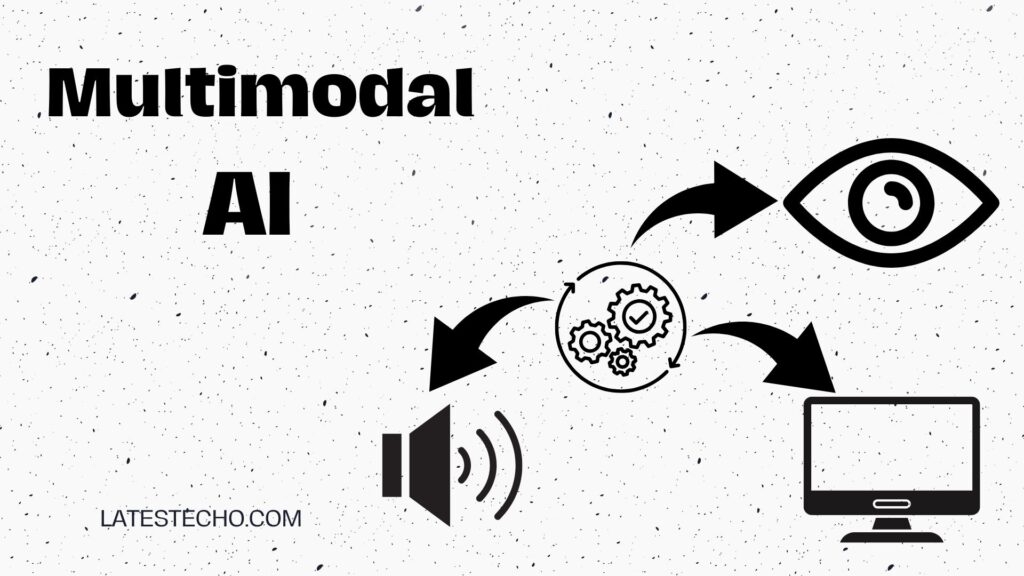
Unleash the Magic of Multimodal AI: See, Hear, Feel
Did you know that modern AI can understand cat memes like humans? That’s the magic of multimodal AI! Every time TikTok suggests a perfect video or Spotify creates the ideal playlist, this modern AI works behind the scenes. According to Stanford’s 2023 AI Index Report, multimodal AI applications grew 300% in just one year.
Highlights:
- Multimodal AI processes multiple types of data simultaneously (text, images, audio, video) – similar to how humans use different senses to understand their environment.
- According to Stanford’s AI Index Report, multimodal AI applications saw a 300% growth in 2023, making it one of the fastest-growing areas in artificial intelligence.
- Popular applications include virtual assistants like GPT-4, self-driving cars, advanced healthcare diagnostics, and smart home systems that combine visual and voice recognition.
- Modern multimodal AI systems achieve 40% higher accuracy in understanding tasks compared to traditional single-mode AI, according to recent OpenAI research.
- From text-to-image generation to advanced security systems, multimodal AI is transforming how businesses and consumers interact with technology across various industries.
Imagine having a conversation with someone while wearing a blindfold and earplugs. That’s how traditional AI often works – with limited senses! According to OpenAI’s research, AI systems that combine multiple types of input can understand our world 40% more accurately than single-mode systems. Let’s dive into the exciting world of multimodal AI and discover how it’s transforming technology, and how it is changing the way we interact with machines.
What Makes AI “Multimodal”?
The human brain processes multiple types of information at once. In the same manner, multimodal AI uses various kinds of data. Think of it as an AI system with super-powered senses. These systems can understand pictures, videos, text, and sound all at the same time. Traditional AI could only handle one type of data. modern AI brings together different capabilities. It’s like giving AI both eyes and ears to understand the world better. This combination helps AI make smarter decisions.
Real-World Examples of Multimodal AI in Action
Voice assistants now recognize both voice commands and gestures. The self-driving cars utilize cameras and sensors to maneuver securely. Similarly, Social media platforms can understand memes by processing both images and text together. Also, Modern smartphones use multimodal AI for face recognition. They combine visual data with depth sensing. This makes unlocking phones both secure and convenient.
How Multimodal AI Makes Life Easier
Smart Home Applications
Smart speakers can now see and hear. They respond to both voice commands and visual cues. This makes controlling home devices more natural and intuitive.
Healthcare Innovations
Doctors use multimodal AI to analyze medical images and patient records together. This helps them make better diagnoses. This sort of technologies provide a thing or an issue that might be missed by humans.
Entertainment and Gaming
Video games now respond to voice commands, body movements, and controller inputs. Streaming services use multimodal AI to recommend content based on viewing habits and user reactions.
The Future of Multimodal AI
Robots will understand human emotions better through facial expressions and tone of voice, not just that but also virtual assistants will become more like real assistants. They’ll understand the context from multiple sources of information. The learning styles of each student will be accommodated by the educational instruments. They’ll consider visual, auditory, and interactive preferences.
Multimodal AI vs. Unimodal AI
Only one kind of data could be processed by conventional AI systems. A speech recognition system worked with audio. An image recognition system handles only pictures. That’s unimodal AI – single-sense artificial intelligence.
Multimodal AI combines different types of inputs. It processes text, images, audio, and video together. This helps AI understand the context better. Just like humans use multiple senses, modern AI uses different data types to make sense of information.
Technologies Associated with Multimodal AI
Computer vision helps AI understand images and videos. Natural Language Processing (NLP) handles text and speech. Audio processing systems analyze sounds and music. Sensor fusion technology combines different data streams. Neural networks process this combined information. The required processing power is supplied by cloud computing.
Text-to-Image Models: Creating Art from Words
DALL-E and Midjourney transform written descriptions into images. These models understand both language and visual concepts. They can create original artwork based on text descriptions.
How Are Text-to-Image Models Trained?
These models learn from millions of image-text pairs. They study the relationships between words and visual elements. The training process involves massive datasets of captioned images. Special algorithms help maintain image quality. The models learn artistic styles and composition. They understand abstract concepts and can visualize them.
Audio-to-Image Models: Converting Sound to Visuals
These models turn sound waves into visual representations. They can create images based on music or speech. Some models even generate music videos from audio tracks.

Popular Multimodal AI Models Making Waves
GPT-4 processes both text and images. PaLM 2 manages coding tasks and different languages. Claude can analyze documents and images together. These models keep improving every month. Their capabilities expand with new updates. They’re becoming more accessible to regular users.
Also Read: Decentralized Applications (dApps): The Next Big Thing in 2025
Generative AI:Demystifyin’ the Mind-Bending Magic
AI in Healthcare: Revealing the Hidden Power
Benefits of Multimodal AI
A better understanding of context improves accuracy. Listed are a few of the advantages.
- Multiple data sources lead to smarter decisions.
- The technology makes human-AI interaction more natural.
- Businesses can automate complex tasks.
- Customer service becomes more efficient.
- Product development gets faster and more innovative.
Multimodal AI Use Cases for Businesses
Virtual shopping assistants combine visual and text data. Security systems use video and audio for better monitoring. Customer service Chabot handles both text and image queries. Healthcare applications analyze medical images and patient records. Manufacturing robots use vision and touch sensors. Marketing tools examine how customers behave through various media.
Challenges to Consider
Data privacy concerns need careful attention. Training requires massive computing resources. Technically speaking, combining various data kinds might be challenging. System maintenance costs can be high. Integration with existing systems takes time. Finding skilled developers can be challenging.
Multimodal AI Risks and Safety Concerns
Bias in training data affects multiple modes. Security vulnerabilities may increase with complexity. Privacy concerns span across different data types. Systems might misinterpret combined signals. Accountability becomes more complicated. Errors can have serious consequences.
Exciting Trends in Multimodal AI
More efficient training methods are emerging. Models are becoming more energy-efficient. Real-time processing is getting faster. Cross-modal learning is improving rapidly. Smaller models are becoming more capable. Integration with AR and VR is expanding.
Conclusion
An important development in artificial intelligence that has been is a multimodal AI. Technology is becoming easier to use and more intuitive as a result. As these systems continue to evolve, they’ll create even more exciting possibilities for how we interact with machines.
Frequently Asked Questions
What is multimodal AI?
Artificial intelligence systems that are capable of analyzing and comprehending a wide variety of data kinds are referred to as multimodal AI. These systems process many input formats simultaneously, including text, pictures, audio, and video. Imagine it as multisensorial AI!
What is an example of multimodal AI?
Virtual assistants like Alexa show multimodal AI in action. They can understand voice commands and show visual responses. Self-driving cars also use multimodal AI. They process camera feeds, sensor data, and GPS information together.
Is ChatGPT a multimodal model?
GPT-4 is indeed multimodal. It can understand both text and images. The earlier version, GPT-3.5, was unimodal. It could only process text input.
What do you mean by multimodal?
Multimodal simply means “using multiple modes or methods.” In AI terms, these modes include different types of data input. Just as humans use multiple senses, multimodal AI uses various data types to understand and respond.
What is multimodal conversational AI?
Multimodal conversational AI combines different types of communication. These systems can understand speech, text, and visual cues. They respond through various channels like voice, text, or visual displays.
How does the future of multimodal AI look like and why is it important?
Multimodal AI will enable more natural human-machine interaction. Future applications include advanced healthcare diagnostics. Smart cities will use this advanced AI for better management. Educational systems will adapt to individual learning styles.
How does multimodal AI differ from other AI?
Traditional AI systems work with one type of data. Latest version of AI processes multiple data types simultaneously. This makes it more versatile and capable. It can understand context better than single-mode systems.
What is distinguishes multimodal AI from generative AI?
Generative AI creates new content. Multimodal AI processes different types of input. Some AI systems can be both generative and multimodal. One example that creates graphics from written descriptions is DALL-E.
What kind of AI can use pictures as a prompt?
Image-understanding AI models can take pictures as input. GPT-4 Vision and Google Lens are popular examples. These systems can analyze images and respond with relevant information.
What advantages do multimodal AI and models offer?
Multimodal AI offers better accuracy through multiple data sources. It provides more natural user interactions. Different sort of complex issues can be handled by this systems easily. They adapt better to real-world situations.

How Apple Siri Lawsuit Settlement Signals a New Era in Privacy Law - Latest Echo
[…] You may also read the latest leaks about the Samsung Galaxy S25, several latest AI innovations like multimodal AI, generative AI, AI in healthcare, and so […]